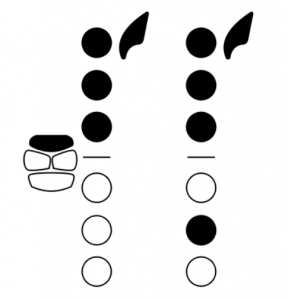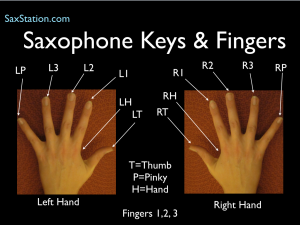If you’re interested in learning more about playing scales, check out the Saxophone Scales Class
“How can I improve my timing?” (on saxophone)
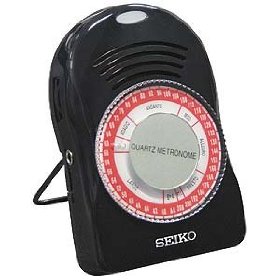 How can I improve my timing? I used to play in a brass band and would see the conductors baton, I find I am not following the metronome, just listening to it
How can I improve my timing? I used to play in a brass band and would see the conductors baton, I find I am not following the metronome, just listening to it
-Richard
My response:
A lot of your rhythm on saxophone has to do with the control of your fingers. You need to be able to make movements that can be fairly different (involving different and more/less fingers & keys) in the same amount of time.
An early step to working on rhythm is to slow things down. You can slow things down a lot if necessary. If you slow things down too much, it’s possible to make the music unrecognizable, so be aware of that.
As you slow down the music, you can more easily concentrate on your fingers. Do you move them consistently? Do you press too hard or not enough? Do you tend to move one finger faster than the other?
Try playing simple music at a slow tempo and see if you can get it in time. With a metronome you can increase the speed by a ‘click’ (usually a few bpm) at a time. Then try increasing the tempo a bit and seeing if you can still play the music in time. Increase in small increments. Eventually you should be able to play it fast.
Part of rhythm is in your head. Let’s say you have four sixteenth notes, do you think of them as individual notes? Or as a group?
If you have other questions about rhythm, go to this page and enter your question. Thinking about putting together a class on rhythm.
https://saxstation.com/what-are-your-questions-about-rhythm.htm
(on saxophone) “I have trouble remembering my fingering with my music notes and scales it drives me nuts”
 I have trouble remembering my fingering with my music notes and scales it drives me nuts, blowing the sax notes is easy I practice and practice and it just don’t stick I come the next day and it’s like I have to learn it all over.
I have trouble remembering my fingering with my music notes and scales it drives me nuts, blowing the sax notes is easy I practice and practice and it just don’t stick I come the next day and it’s like I have to learn it all over.
(Playing 3 1/2 years, practices 3 days/week)
-Robert
My response:
First off, I would recommend increasing the number of days you practice. It’s going to be hard to remember many things if you work on them less than half of the days of the week.
It’s possible that you’re also trying to learn too many notes or scales at once. Trying to learn one or two scales in a day is fairly reasonable, depending on your prior experience. Trying to learn 34 scales in a day is unlikely to happen!
You may also want to alternate between the scales you are learning. If you repeat a scale many times, it goes into your short term memory and you will begin to feel like you know it. That doesn’t mean it’s really in your long term memory.
If you would like to check out my class on scales, you can find it at
“Why do we have to use the register key on some notes?” (for saxophone)
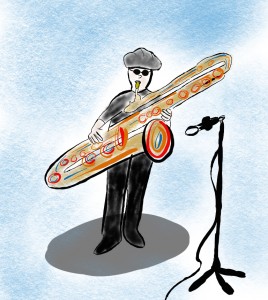 Received two similar questions about the octave key on the saxophone. Leave a comment below with additional questions.
Received two similar questions about the octave key on the saxophone. Leave a comment below with additional questions.
Why do we have to use the register key on some notes?
-Camden
The key at the back of my upper left hand when exactly am I obligated to press it.
-Shedrack
My response:
You can play different notes on the saxophone by effectively changing the size of the saxophone (where the air comes out). If you press all the keys that cover the tone holes, you get a low Bb.
If you want to think about the physics of it all, notes sound from the saxophone because you create standing waves with the air inside the horn (if you don’t want to think about that, don’t worry too much about it!). You cover and uncover different holes in the tube of the saxophone to change the length and properties of the instrument.
The position and size of the hole for the octave key has the effect of raising notes by one octave. That does not mean it is absolutely required to get the sound of the note (you may have experienced playing overtones even on accident), but it does make it easier to get certain notes.
The effect of pressing the octave key is to raise the lower notes by exactly one octave. The notes an octave apart have the same letter names. So playing a G with three fingers on the left hand and then playing the G with three fingers and the octave key means the notes are an octave apart. Physically, an octave above means doubling the frequency of the note.
“….playing a phrase (on saxophone) that involves, let’s say, E# going to G# then resolving to F# (F# harmonic minor), it won’t come out evenly.”
I’m very frustrated right now because every time I’m playing a phrase that involves, let’s say, E# going to G# then resolving to F# (F# harmonic minor), it won’t come out evenly.
It’s like my pinky finger is lagging behind and its causing me a lot of problems in my playing, this has never happened to me before and right now I’m trying to practice slow to see if I can figure it out.
Please let me know what do you think i should do because I’m not a beginner, I’ve been playing and this is not supposed to be happening right now.
(Playing for seven years)
-Louis
My response:
Try to lift/press your pinky early and see if that makes it on time.
Practicing slowly is a great idea, that should help you work it out.
It’s possible this was happening before and you didn’t notice it. Or potentially it is a new problem, in which case you have identified it and have an idea of how to work it out.
Possible that you slowly developed a bad habit of the pinky moving more slowly.
Another possibility is that a key on your saxophone is sticking, I would check for that too.
Overall, many note transitions simply involve more coordination than other transitions. If you’re only moving one finger, it’s difficult to do it wrong. When you need to do a combination of pressing/lifting of seven fingers, you need a lot more precision.
Check out Saxophone Tribe if you want to work more with me on technique.
-Neal
“How can my ten fingers handle all the keys on the sax?”
 How can my ten fingers handle all the keys on the sax?
How can my ten fingers handle all the keys on the sax?
(Playing for one week)
-Fori
My response:
On the diagram on the right, we see 23 keys.
Your saxophone might be a tiny bit different, not having a high F# key, having a low A key, or potentially having a few other differences if it’s really old. But basically a saxophone has 23 keys.
Some of your fingers are only responsible for pressing one key. Other fingers are responsible for multiple keys.
You use 9 of your fingers to press keys on the saxophone. Your right thumb, underneath the thumb rest is exempt.
Here is a diagram with your fingers labeled, as well as the side of the hands as ‘LH’ and ‘RH’
Left Hand
Your left thumb is in charge of pressing one key, the octave key.
The first finger on your left hand (L1) can press three different keys- B, bis key, high F key
With the option of pressing two at once (B key and bis key).
The second finger on your left hand (middle finger, L2) presses only one key, the one to play ‘C’.
The third finger on your left hand (L3) presses only one key.
Your left pinky can press any of the four table keys.
The side of your left hand (LH) can press the three palm keys. One, two or three at a time depending on the note you want to play.
Right Hand
Your right thumb goes under the thumb rest, it presses no keys.
The first finger on your right hand (R1) presses one key.
The second finger on your right hand (middle finger, R2) presses only one key.
The third finger on your right hand (R3) presses one key normally and can press two others, the alternative F# and the high F#.
Your right pinky can press the two bottom keys for D#/Eb and low C.
The side of your right hand (RH) can press the three keys. The most common one being side Bb, another for an alternative C and a third for higher notes.
“How to sound more smooth?” (on saxophone)
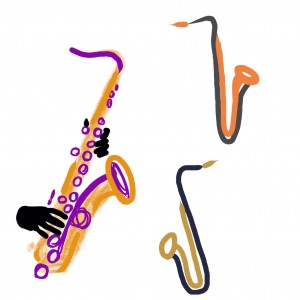 How to sound more smooth? I own a tenor saxophone and its the first time I ever play a saxophone.
How to sound more smooth? I own a tenor saxophone and its the first time I ever play a saxophone.
(has been playing 3 days so far, plans on practicing 5/6 days a week)
Every time I blow into the mouth piece I get the sound of the sax but as I change the notes/chords, the sound kind of breaks off or dies down, if not, sometimes it screeches.
Even when I play low notes, every time I blow into it it sounds a little a high pitched. and if I blow normally I dont get any sound out of it.
I don’t get any sound either when I blow slowly so that the volume of the saxophone drops a little. I have no problem with the chords or notes it’s just sounding right is the major problem.
I changed my style of blowing and watched many videos to help me get it right but for some reason it doesn’t sound smooth at all.
It goes smooth for the first note but then after that it goes up to a screechy sound or down to no sound at all.
I’m not sure if I’m doing it right to be honest but the way I sound so far, I must be doing something wrong.
On day 1:
No sound but after half an hour i made my first sound then was able to get it right as my reed wasn’t moist enough and learned how to play pink panther in an hour.
Most importantly I want to know how to freestyle solo or improvise my own solo on my saxophone.
–Faisal
My response:
There are many elements as you try to sound more smooth on saxophone.
Practice
That’s good that you plan on practicing 5/6 days a week. Six would be better than five and if you can practice everyday of the week sometimes, that would be even better.
Reed
It’s possible you’re using a reed that is too hard for you, having only played three days so far.
I would say a 2 or 1.5 would be about right for now.
Fingers
After three days of playing saxophone, the movements of your fingers are likely not perfectly synchronized. And any problems there will disrupt the flow of air and your sound. This will take work and awareness.
Certain transitions require a lot more precision than others. Think about the difference between moving one finger to change a note and lifting/pressing seven fingers at once. The second is a more complicated movement and everything needs to line up. If things don’t line up, it makes the sound not smooth.
Expectations
You have been playing three days. Not three weeks or months or years.
You’re also playing tenor, which requires a bit more air than alto.
First thing I would check is the number on your reed. After that, keep practicing. And realize that it will take quite a bit of work to attain a smooth sound. Part of it is your embouchure and more than you may think is your fingers.
Check out my saxophone classes/books if you’re interested in learning more from me.
-Neal
Minion Playing Saxophone (Drawing)
Felt like drawing a minion playing saxophone!
You can see more drawings of saxophones and other things as well as some photos on my Instagram account
What is the best approach to improve my sound (on saxophone) (tonguing, getting more volume, play by ear, improvising/soloing)
What is the best approach to improve my sound (tonguing, getting more volume, play by ear, improvising/soloing)
(Has been playing 10 years, practices three days a week)
(Has not yet tried to learn anything by ear)
-Brent
My response:
Not an especially specific question, but it basically has a straightforward answer.
First thing would be to practice more. If you’re aware of your sound, it should get a little bit better every time you play.
Practicing three days a week means you’re practicing less than half of the days in a week.
Each day you don’t practice, you get a little bit worse.
Volume depends a bit on which reed and mouthpiece you use, but also on your physical condition.
To get better at learning music by ear you have to start learning music by ear. To do that, I would recommend starting with simple melodies that are played slowly. Learning Taps by ear on saxophone could be a good start.
Pretty much anything you do on saxophone will get better by practicing more.
“I know you are supposed to use your tongue to separate your beats….” (on saxophone)
I know you are supposed to use your tongue to separate your beats, but I can’t do it right, so I use my throat and separate breaths.
I am only in beginning band, but everyone is better than me.
How do I fix my problem?
-Carmella
Keep working on tonguing.
It’s something you have to learn to play well.
I did the same thing with separate breaths for a couple of weeks at the very beginning and had to switch to tonguing.
-Neal
Thanks. I actually got help from a friend and I am sorta good now.
-Carmella
“Are all saxophones in E flat?”
Question:
Received this question the other day about the key of saxophones.
“Are all saxophones in E flat?”
-Emmanuel
My response:
Tenor sax and soprano sax are both in the key of Bb.

